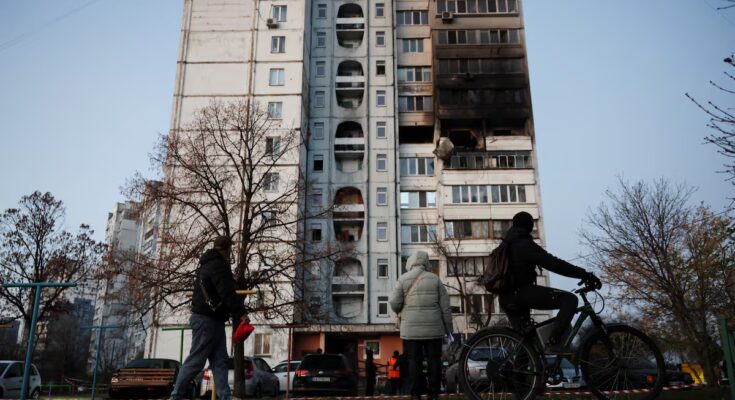Valery Khodemchuk literally disappeared on April 26, 1986, when reactor 4 of the Chernobyl nuclear power plant exploded. Valery was in the reactor water circulation pump room. His body was never found, but he was recorded as the first casualty of the worst nuclear disaster in history. Nearly four decades later, his widow, Natalia Khodemchuk, died last Saturday at the age of 73 in a Kiev hospital: the night before, a Russian drone attack had hit her apartment while she slept.
The resulting fire left a black stain on the seventh floor of the building, around what was Khodemchuk’s apartment. It is a 20-storey building, an imposing structure on the outskirts of Kiev. Some of the families displaced from Pripyat, a city near Chernobyl, have been relocated there. Pripyat is now a ghost town, frozen in time, famous as a pilgrimage site for disaster tourism.
Khodemchuk was displaced from Pripyat to Kiev, just over 60 miles south of the nuclear power plant, with almost nothing but the clothes on her back, with the few things the Soviet military allowed her to pack before leaving her home forever. He made the trip together with other families of employees of the plant, such as Marina Voloshina’s father-in-law. “Natalia was an icon, we all knew her, but my father-in-law was also remembered as a hero: he saved his colleagues at the plant,” explains Voloshina, stopping at the bar she manages in the neighborhood. This man, who passed away in 2024, was one of the first “liquidators”, the plant employees who, in the aftermath of the disaster, prevented further explosions. One of the most famous liquidators, Oleksiy Ananenko, also lived in Khodemchuk’s building.
Both Ananenko and Valery Khodemchuk are characters who appear in the acclaimed TV series Chernobylbroadcast on HBO in 2019.

The bombed building is part of a Kiev neighborhood built just over a year ago to house Chernobyl evacuees. The block is one of the places featured in the famous 1987 documentary The Chernobyl bell. This film by director Rollan Sergienko shook the Soviet Union. Both the nuclear disaster and the end of the invasion of Afghanistan were crises that accelerated the disintegration of the USSR.
Voloshina lives on the sixth floor of the building and her face still reflects the anguish of what happened on November 14. That morning Russia dropped more than 400 Shahed drone bombs on the Ukrainian capital. Fourteen impacts on civilian buildings were recorded. One of these Shahed drones was the one that killed Khodemchuk, the seventh victim of that bombing.

Voloshina believes the drone’s target was an electrical substation near the neighborhood. Russia is waging a campaign to destroy Ukraine’s energy system, causing power outages of up to 14 hours a day in the country’s major cities. For her, the worst memory of that early morning was seeing one of her neighbors, a friend of hers, walk out of his apartment with half his body burned. “He saved his two children by forcing the door in the middle of the flames,” Voloshina says, holding back tears. “She was alone because just the day before her husband had been drafted into the army.” Voloshina’s neighbor was one of 36 people injured in the Russian bombing.
Natalia Khodemchuk was known in Ukraine for her activism in remembering the victims of the nuclear disaster, the State Agency for the Chernobyl Exclusion Zone noted in a statement. President Volodymyr Zelenskiy also dedicated a message to her on social media: “Almost four decades later, Natalia died in a new tragedy caused by the Kremlin. The Ukrainians who survived Chernobyl, who helped rebuild the country after the disaster, once again suffer the danger and terror of an aggressor state.”
Khodemchuk shared a similar profile with other women interviewed by Nobel laureate Svetlana Alexievich in her acclaimed Voices from Chernobyl. This book also collects the testimonies of children whose lives were completely changed by the catastrophe: “I was little, eight years old – says one of them – I was afraid of running barefoot in the grass. My mother scared me by saying that I was going to die. I was afraid of bathing, of diving into the water… Scared of everything. Picking up hazelnuts in the woods. Picking up a beetle with my bare hands, because the beetles walked on the ground, and the land was The “ants, the butterflies, the flies, everything was contaminated.”

That boy could have been Oleksandr Shinkaruk. When the Chernobyl reactor exploded, he was also eight years old and living in Pripyat. Today he lives on the same floor of the same building where Natalia Khodemchuk died. He survived, he says, with his hands still shaking from the trauma, 24 hours after the crash, because his apartment faces the opposite side of the drone’s impact. Shinkaruk and a friend are unloading repair materials into a van. On November 14, he says with a nervous smile, he turned 48.
Was he also shaking with nerves when the atomic catastrophe occurred? “I can’t make comparisons,” says Shinkaruk, “that night we saw a flash of light in the sky, but nothing more. And the next day we went to school. They gave us some iodine tablets and we also had two hours of lessons. But then they told us we had to go home.” “What’s happening now has affected me much more,” he admits, “especially the buzz of the Shahed; you feel it approaching, you feel helpless, you don’t know who will strike.”
Sign up to our weekly newsletter to get more English-language news coverage from EL PAÍS USA Edition



